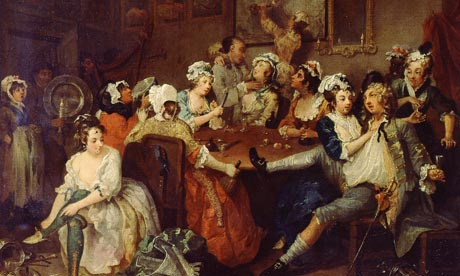
Britain and London are virtually synonymous in the eyes of the world. The eve of the Olympics is a good time to go back to the century that saw the making of Britannia and the London we walk and live in today. Jerry White's history of 18th-century London is the culmination of two previous volumes about London in the 19th and 20th centuries. This new book finds him inspired by the city that Daniel Defoe identified as "this great and monstrous Thing called London".
In 1700, it was divided, in separations that linger, into three: the City (London), the court (Westminster and St James's) and south of the river (Southwark). The essayist Joseph Addison, in 1712, looked on it as "an aggregate of various nations distinguished from each other by their respective customs, manners an interests". In 1700, its population numbered about half a million, swelling to approximately 750,000 by 1750 and roughly a million by 1800. By contrast, England's second city, Bristol, had scarcely 30,000 inhabitants.
London was not just staggeringly larger than anywhere else, it was also a vivid new metropolis, much of it in soft pink brick. The Great Fire of 1666 had left more than half of the old city in smouldering ruins. After the union with Scotland, the capital became the outward sign of British prosperity and self-confidence. And the people most attracted to it, for its teeming opportunities, were the Scots.
Georgian London became a Scottish city. Its main architect, James Gibbs, was Scottish. So was the circle that formed around the young George III. That great Londoner, Samuel Johnson, loved to goad the Scots, but his amanuensis, James Boswell, was one himself, and so were five of the six assistants on his famous Dictionary. Scots in the capital often attracted hostility. When officers in highland dress appeared at Covent Garden, the upper gallery yelled: "No Scots! No Scots!" and pelted them with apples.
In other ways, Britannia's London was more extreme but not so different from our own: prey to rioting, seething with sex and violence. Visitors to London, appalled by the atmosphere, also noted what one described as "the vast number of harlots" roaming the streets by night. London was the sex capital of Europe, but hardly uplifting. "She was ugly and lean," wrote James Boswell of one encounter in the park, "and her breath smelt of spirits. I never asked her name. When it was done, she slunk off."
White's account is not exactly new. Much of this book reads like an animated Hogarth cartoon. But he has uncovered a wealth of evidence to sustain a portrait of a society revelling in money and pleasure in ways that recall the excesses of the 1980s.
Contemporaries saw the city as a marketplace for every kind of trade. In the mixing of vice and fashion, there were remarkable social consequences at work, too. White argues persuasively that historians have paid insufficient attention to the role of prostitution in the rise of democracy. It's a pleasing picture that while the women of the town flirtatiously dissolved the bonds of deference, London became a democratic crucible.
But there was a dark side. "Crime and criminals," says White, "knew no bounds of rank in 18th-century London." Suicide was common, executions a public spectacle. Violent property crime rose. In 1780, with the outbreak of the Gordon riots, London seemed on the brink of civil war.
In early June, the mob attacked 10 Downing Street and then moved on to batter the city's prisons, destroying Newgate. It has been calculated that these riots destroyed 10 times more property than was destroyed in Paris during the entire French revolution.
The repression of the 1790s was the response of an establishment reasserting state control. The French revolution and the wars that followed loosened the city's devotion to popular democracy and brought merchants and courtiers from the east and west ends into a loyal alliance behind the throne. London had become the world capital it remains today.

